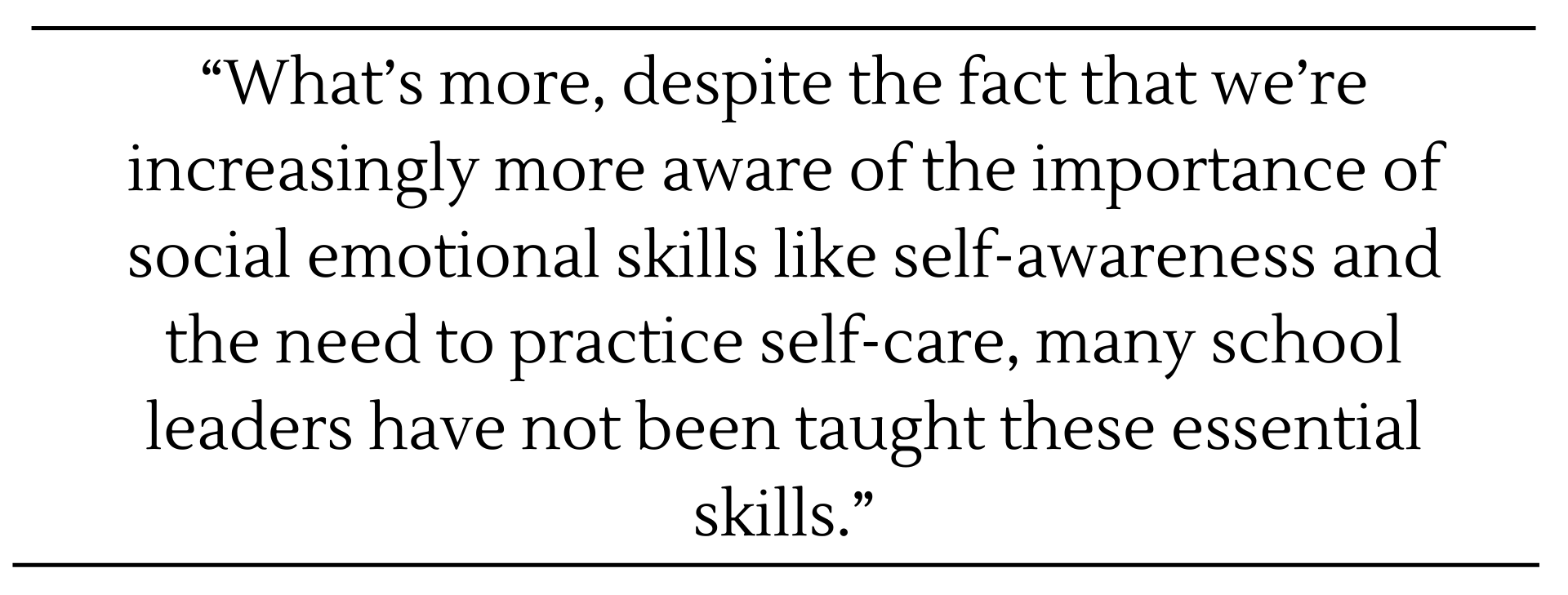Stress and burnout are on the rise among Canadian principals and vice-principals
Here are 3 reasons why you should care
Principals and vice-principals are facing increased pressure, workload, and stress.1 But considering how pervasive stress and burnout seem to be across many professions in modern society, why should we care specifically about school leaders? The answer is actually so very clear: health, happiness, and success for everyone! Of course, work-related stress is normal and inevitable; however, excessive physical and emotional stress can interfere with school leaders’ well-being which can carry over to ultimately impact education systems as a whole.

WHEN LOOKING AT SCHOOL LEADERS’ WELL-BEING, THERE ARE THREE INTERCONNECTED COMPONENTS TO CONSIDER:
1. The Individual: Stress inhibits school leaders from effectively improving school performance
Principals and vice-principals (VPs) are some of our most dedicated and passionate educators who have chosen to take on a role with significant responsibility and impact, which means that we need them to be at their best. One might say that handling difficult tasks and juggling many needs is simply the role of school principals and VPs. That is absolutely correct! This is exactly what our best leaders are good at and often thrive on. However, our bodies are not designed for the levels of constant and excessive stress that many of our school leaders are currently experiencing.

Chronic stress lowers levels of health, happiness, and success – and leaders aren’t immune from these innately human factors.2 If principals and VPs are working days, nights, and weekends (and they often are), then they are indeed experiencing chronic stress, which will take a toll on their social, emotional, and cognitive well-being,3 just like anyone else. Work-related stress can have damaging effects that inhibit school leaders’ ability to function effectively while lowering their job enthusiasm and motivation to perform well.4 Stress not only affects the ability of school leaders to improve their schools but also makes it difficult to retain and recruit new principals and VPs.

Research shows that most principals burn out and leave the profession in four years or less, although it takes five-to-seven years for a principal to have a significant impact on a school community.5 Yes, we need principals to do their job now, but we also need them to stick around long enough to yield the greatest results possible for students. What’s more, despite the fact that we’re increasingly more aware of the importance of social emotional skills like self-awareness and the need to practice self-care, many school leaders have not been taught these essential skills. More importantly, leaders often assume that they can’t possibly worry about themselves since they’re tasked with taking care of everyone else. However, it’s good to be reminded of the simple truth that we’ve learned from air travel, which is that it’s not only important – but essential – to put on your own oxygen mask before helping others.
2. The Group: Education is a collective endeavour – not one person’s job
If you are a parent, student, or school staff member, then this is one of the most compelling arguments for why you should care about your principals’ or vice-principals’ stress levels. It takes a community – if not a village – to raise a child. The most productive and successful work teams are made up of people who care about each other. People on successful and productive teams use the words family, support, and trust to describe their work together. It isn’t enough to have great individuals. Principals and VPs aren’t superheroes, nor should they be the sole go-to people who are expected to triumph against all odds. They are regular people whose health and well-being should be of equal concern, not an afterthought. For schools to function well, all staff need to work as a team towards a common goal. To do our best work, we need to have strong, connected teams built on relationships and trust.

What we know about workplace well-being is that the best teams are those that understand the importance of social connection and creating a workplace where people feel safe and valued. If school leaders don’t feel connected or supported by their team, then they’re not only less effective but so is everyone else. If leaders are connected and have strong, authentic relationships then the people that work for them will go out of their way to make their leaders’ and the organization’s vision come true.6 When we work for someone who we care about and who we feel cares about us as employees, then we will work with passion, dedication, and creativity. What’s more, when we hold this sense of care as a group, the results are amazing!

Fundamentally, work and life aren’t things we can ever do alone – nor are we meant to.7 We’re at our best when we work together and, just as we know that stress can actually spread and be contagious towards those around us,8 we also know that the “good stuff” is contagious, too. For instance, it has been scientifically proven that when we show gratitude and compassion towards other people, they feel better, perform better, and are more likely to reciprocate acts of compassion and belonging.9 So, no matter who we are and what role we may find ourselves in, we can always make the choice to act first by showing compassion, assuming good intention, and being kind. It’s important for leaders to both show and receive these positive actions. Above all, we need leaders who feel safe, valued, and connected in order for them to do their best work and to inspire and support their staff – and ultimately their students – to do the same.

3. The System: School leaders are running systems that aren’t designed to support their well-being
Surveys of principals demonstrate that education systems are overloading our leaders.10 A rapid flow of policies, initiatives, and programs leads to loss of focus, overwork, frustration, and demotivation11 – and these are impacting school leaders’ health and well-being while increasing their levels of stress. As this makes it more difficult to recruit and retain the best school leaders, school districts are faced with high costs in terms of both time and money, which further inject stress into the system.

It’s important to name this tension while also being very clear that this isn’t a criticism towards – or the responsibility of – any one person or group of people. Rather, this tension indicates that education systems as a whole need to look at practices through the lens of workplace well-being. As such, looking at practices through a well-being lens can lead to large-scale change that, as the First Peoples’ Principles of Learning remind us, will take time and patience. However, rethinking system-level practices can also involve small changes that simply require a willingness to try – and we need both large and small changes.
THE TAKEAWAY
While it’s encouraging that many associations, ministries of education, and partner groups are beginning to focus on the issue of workplace well-being in K-12 education, we still have a ways to go in acknowledging the importance of principals and vice-principals’ well-being – leaders of learning who have huge impacts on the health, happiness, and success of our schools. For school leaders reading this, remember that well-being has three interconnected components: you, your team, and the system as a whole. You were never meant to do this job alone.
References and Further Reading
1Alberta Teachers Association (ATA). (2017). The Canadian school leaders: Global forces and future prospects. A research report. Edmonton, AB.
Canadian Association of Principals (CAP). (2014). The future of the principalship in Canada: A national research study. Kanata, ON.
Pollock, K., Wang, F., & Hauseman, D. C. (2014). The changing nature of principals’ work: Final Report. Ontario Principals’ Council, Toronto, ON.
Pollock, K., Wang, F., & Hauseman, D. C. (2015). Complexity and volume: An inquiry into factors that drive principals’ work. Societies, 5(2), 537–565.
Pollock, K., Wang, F., & Hauseman, D. C. (2017). The changing nature of vice-principals’ work: Final report. Ontario Principals’ Council, Toronto, ON.
Poirel, E., & Yvon, F. (2014). School principals’ emotional coping process. Canadian Journal of Education/Revue Canadienne de L’éducation, 37(3), 1–23.
Riley, P. (2016). The Australian principal occupational health, safety and well-being survey. Institute for Positive Psychology & Education. Retrieved from: http://www.principalhealth.org/au/2016_Report_AU_FINAL.pdf
U.S. Bureau of Labor Statistics. (2016). Occupational outlook handbook: Elementary, middle, and high school principals. U.S. Department of Labour. Retrieved from: https://www.bls.gov/ooh/management/elementary-middle-and-high-school-principals.htm
2Hallinger, P., & Murphy, J. F. (2013). Running on empty? finding the time and capacity to lead learning. NASSP Bulletin, 97(1), 5-21. doi:10.1177/0192636512469288
Nthebe, K., Barkhuizen, N., & Schutte, N. (2016). Rewards: A predictor of well-being and service quality of school principals in the north-west province. SA Journal of Human Resource Management, 14(1), 1-e11. doi:10.4102/sajhrm.v14i1.71
Poirel, E., & Yvon, F. (2014). School principals’ emotional coping process. Canadian Journal of Education/Revue Canadienne de L’éducation, 37(3), 1–23.
3Wang, F., Pollock, K., & Hauseman, D. C. (2018b). Ontario principals’ and vice-principals’ well-being and coping strategies in the context of work intensification. In S. Cherkowski, & K. D. Walker (Eds.), Perspectives on flourishing in schools (pp. 287-303). Lanham, Maryland: Lexington Books, an imprint of The Rowman & Littlefield Publishing Group, Inc.
4Devos, G., Bouckenooghe, D., Engels, N., Hotton, G., & Aelterman, A. (2007). An assessment of well-being of principals in flemish primary schools. Journal of Educational Administration, 45(1), 33-61. doi:10.1108/09578230710722449
5Leithwood, K. A., Louis, K. S., & Anderson, S. E. (2012). Linking leadership to student learning (1st ed.). San Francisco: Jossey-Bass.
6Sinek, S. (2014). Leaders eat last: Why some teams pull together and others don’t. New York: Portfolio/Penguin.
Sinek, S. (2011). Start with why: How great leaders inspire everyone to take action. New York: Portfolio / Penguin.
7Walton, G. M., Cohen, G. L., Cwir, D., & Spencer, S. J. (2012). Mere belonging: The power of social connections. Journal of Personality and Social Psychology, 102(3), 513-532. doi:10.1037/a0025731
8Sterley, T., Baimoukhametova, D., Füzesi, T., Zurek, A. A., Daviu, N., Rasiah, N. P., & Bains, J. S. (2018). Social transmission and buffering of synaptic changes after stress. Nature Neuroscience, 21(3), 393-403. doi:10.1038/s41593-017-0044-6
9Coyle, D. (2018). The culture code: The secrets of highly successful groups (1st ed.). New York: Bantam Books.
10Wang, F., Pollock, K., & Hauseman, C. (2018a). School principals’ job satisfaction: The effect of work intensification in Ontario. Canadian Journal of Educational Administration and Policy, 185, 73-90.
Wang, F., Pollock, K., & Hauseman, D. C. (2018b). Ontario principals’ and vice-principals’ well-being and coping strategies in the context of work intensification. In S. Cherkowski, & K. D. Walker (Eds.), Perspectives on flourishing in schools (pp. 287-303). Lanham, Maryland: Lexington Books, an imprint of The Rowman & Littlefield Publishing Group, Inc.
11Fullan, M. (2008). What’s worth fighting for in the principalship? (2nd Ed.). New York: Teachers College Press.
